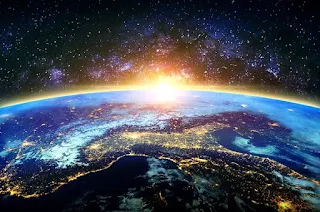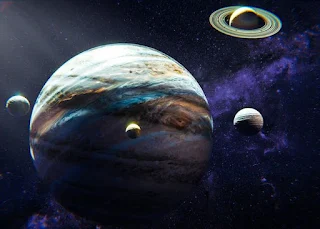It seems that before we die we want to reveal a little about the secrets of the stars in the universe. Create God, the challenge for humans to explore is this universe. Humans with their brains according to the origin of life on this earth are closely related to what happened millions of years ago in an event in this universe.
The opinion of scientists is divided into two poles regarding the origin of the universe, one camp departs from direct observation or observation that gave birth to the science of astronomy, while the second camp is based on exact exact theory which gave birth to the physical science of cosmology. They issued their own theories about the universe. These theories contradict each other.
Universe in Science
One of the sciences that studies the universe is astronomy. This science is another part of natural science that studies the situation in the sky or space, including celestial bodies, celestial phenomena, and the order of the outer planets. Astronomy is the oldest branch of human creation. The universe in ancient times was something secret and great in nature.
According to the myths of ancient people, the universe is a reflection of the gods worshiped by humans. Therefore, the objects of the universe become the benchmark for doing everything. The forms of worship and rituals can be seen from the fragments found in the Egyptian Pyramids, reliefs from the Mayans, besides that the calendar is also pegged from stargazing.
Likewise, the ancient people of the archipelago worship the universe you can see on the walls of the temple, the phenomena of the universe are also applied in Indonesian folk myths.
Astronomy is a branch that can be studied through formal and informal institutions, because all of them are based on the same medium, namely the observation of the universe. An easy example is when Muslims determine when Eid al-Fitr arrives, they use the benchmark month.
The next example is the position of the star used as navigation for sailors who are sailing in the middle of the ocean. While modern astronomy studies the outermost phenomena of the universe, such as supernovae, nebulae, planets, sun and so on. Of course, to explore more deeply the secrets of the universe there, using sophisticated support equipment.
The Universe - Bosscha Evidence of Progress in Indonesian
Astronomy Modern astronomy in Indonesia has been developed since the Dutch era. The secret of the universe intrigued the Dutch government to develop a space laboratory in the Dutch East Indies.
Precisely in 1923, a sky observation laboratory was built in Lembang, the construction of which took five years and was introduced to the public in 1933 under the name Bosscha Sterrenwacht. This sky laboratory was built on an area of 5 hectares owned by Karel Albert Rudolf Bosscha, the landlord of a tea plantation in Malabar.
For his services to the concern for the development of astronomy, he was given the honor, his last name was used as the name of the sky observatory complex. After Indonesia's independence, the activities of researching objects in the universe continued because this science was independent.
However, in 1951 the administrator of the Observatory was changed from Nederlandsch-Indische Sterrenkundige Vereeniging (NISV) and handed over to the Bandung Institute of Technology.
The universe observation complex at Bosscha has five giant telescopes left by the NISV, all of which are in good condition. Currently Bosscha is used as an astronomy research laboratory by ITB students and other researchers.
This observatory is also used as an object of study for students who are conducting study tours. Unfortunately, due to environmental encroachment factors in Lembang, which are increasingly dense, have disrupted the research activities of the universe.
Peeking at the Residents of the Heavenly Universe
It is very interesting to look at the phenomena that exist in the universe, especially the celestial bodies scattered over the earth. The science of astronomy that studies the solar system can actually be studied by anyone, not only students or scientists, ordinary people can explore astronomy independently.
The following are objects of the celestial universe that are used as objects of observation by astronomy lovers, in the form of planets.
Universe - Planets
Planets are part of the celestial universe that rotates around the sun or stars as the source of their orbits. The spherical shape of the planet has its own mass and gravity. Our solar system consists of nine planets and one sun as its axis of rotation.
The planets are:
1. Universe - Mercury
Mercury is the closest planet to the sun, the planet Mercury is 4879 km in diameter. Mercury is the smallest planet, its diameter is smaller than the planet Earth. The planet Mercury does not show the existence of life there, because the temperature on Mercury is so hot because the distance from the sun is 57.9 million Km. Exposure to fire flares from the sun causes Mercury's surface to be full of radiation.
2. Universe - Venus
The second order of members of the celestial universe is the planet Venus. The radius of Venus is 6,052 Km, this planet takes 225 days to orbit the sun as the axis of rotation of the solar system. The planet Venus or other terms is this morning star when viewed through binoculars, it looks cloudy white and there are black streaks around the planet's surface. This cloudy white color is a layer of carbon dioxide atmosphere.
The high concentration of carbon dioxide causes no life on the planet Venus. The distance of Venus from the sun is 108 million km, while the distance between Venus and Earth is about 42 million km. The surface temperature of the planet Venus during the day is 430 degrees Celsius, how hot the planet Venus is, this is because its position is close to the sun.
3. Universe - Earth
The next level of the universe is planet Earth, which ranks third. Earth or earth has a diameter of 12,756 km, the Earth that we walk on takes 365 days to rotate around the sun, this full rotation period is used as a year unit as a calendar benchmark.
Earth is the only planet inhabited by living things. The Earth's atmosphere that covers the Earth's surface, serves as a protector of the universe's objects in the sky and keeps oxygen circulating from evaporating.
The celestial body closest to Earth is the Moon, it can be said that the Moon is a satellite of the Earth, the Moon is active around the Earth for 30 days. Temperatures on the Earth's surface vary depending on geography, for example in the tropics the average temperature is 17-39 degrees, while the subtropical areas include the north and south poles reaching -40-30 degrees Celsius.
4. Universe - Mars
The fourth planet in the universe in the sky is Mars, which has a period of 687 days to orbit the sun, the orbital period of Mars is twice that of Earth. The diameter of the planet Mars reaches 6,790 km. Mars is more than half the size of Earth. Because of its position away from the sun, the temperature on the surface of Mars is lower than that of Earth.
Mars is a planet that is being studied further by humans, the low temperature of Mars is believed to hold water reserves. Human hope, the planet Mars can be inhabited by humans in the future, given the population of the earth is increasingly dense.
5. Universe - Jupiter
Jupiter is a planet that occupies the fifth position of the nine ranks of the planets found by humans in the universe. Jupiter is one of the largest planets as evidenced by the circumference of this planet reaching 142,600 km, while the distance from the sun reaches 778 million km.
The temperature on the surface of this fifth planet reaches -140 degrees Celsius to 10 degrees Celsius, the cold is very extreme because it is far from the sun.
6. Universe - Saturn
The sixth planet is named Saturn, from its physical appearance it is easy to identify because it has rings around the diameter of the planet. This large planet is 120,200 km in diameter, the planet Saturn has eleven moons, all rotating around Saturn. While the ring that surrounds the planet consists of three parts. Saturn's atmosphere consists of ammonia, helium and carbon dioxide.
7. Universe - Uranus
Uranus is the seventh planet discovered by humans in the universe, this planet is four times larger than Earth's diameter which is 49,000 Km. Uranus takes 84 years around the sun, a long orbital period because the distance from Uranus to the sun reaches 3000 million Km or 3 billion Km.
The planet Uranus has rings that circle but are not as dense as Saturn. In the celestial universe of Uranus there are also five active Moons surrounding Uranus like satellites.
8. Universe - Neptune
One of the outermost planets of our universe is Neptune, the distance from the sun to Neptune is close to 4 billion km, with its planetary circle reaching 49,530 km, making the planet Neptune the fourth largest planet in the universe. The distance with the source of rotation is very long, every one of Neptune's orbit is covered in 164 years, almost a century and a half.
Actually, there are still many secrets of the universe that have not been revealed by the human eye. The secret of the universe will forever be a mystery known only to God. While some of these secrets are evidence of how great humans are who are gifted with reason by God. These are some of the secrets of the universe that are made into knowledge by humans.


